Biostar IDEQ 330P
Overview
Moving on to the newcomers, we have the most recently launched 939 SFF from Biostar. Biostar is a tier two manufacturer that has been around for some time. They've been making motherboards for a long time, and they've also been in the SFF market almost as long as Shuttle. Their IDEQ line has included some innovative and creative approaches, and the new 300 series offers some of the more interesting features that we've seen. We're looking at the 330P for this roundup, and it certainly has a lot to offer.Aesthetics
The first impression of the 330P is that it's shiny. Really shiny! (It also attracts fingerprints and dust exceptionally well, but that's typical of high-gloss surfaces.) Some people may prefer a matte finish instead, but the glossy paint definitely gives the 330P an air of sleekness. We've seen quite a few SFF cases now, and whatever else you might say of the 330P, it certainly stands out from the crowd.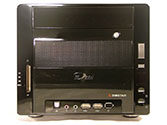 |
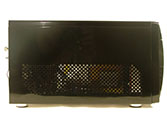 |
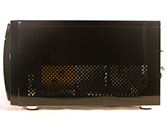 |
| Click on images to enlarge. | ||
The Biostar case is actually a bit wider than most of the other cases, but there's a reason for that. We also like the less obtrusive front panel lighting; a couple of indicators for HDD and power are all that you see, though the power button does glow orange when the PC is turned off. Something else that we like is that Biostar didn't bother with a door to hide the USB and other front ports. We use such ports frequently, so a door just gets in the way and is one more part that can break off.
One of the few items that give us any cause for concern as far as appearance is the front grille, where air is pulled in to cool the CPU. Dust is bound to collect there over time, and while it may serve as a reminder that it's time to clean out the inside of your PC, ignorance is bliss. It's a minor point, and some people will just like the visual highlight that it provides. Just remember to wipe it off with a damp cloth periodically and you should be fine.
Features
|
Biostar 330P
|
||
| Dimensions | (w)215 mm x (h)185 mm x (d)355 mm | |
| CPU Support | AMD Socket 939 up to FX-57/X24800+ | |
| Memory Support | PC1600/PC2100/PC2700/PC3200 up to 2GB; 2 DIMM slots |
|
| Motherboard | K8NBD-S9 (proprietary) NVIDIA nForce4 Chipset (not Ultra, not 4X) 1X-5X (200-1000MHz) HyperTransport 8-bit/8-bit to 16-bit/16-bit HT Width |
|
| Flash Reader | CF I/II, MD, SM/SMC, SD, MMC, and MS/MSP | |
| Expansion Slots | 1 x PCIe X16; 1 x PCI; 1 x mini PCI | |
| Power Supply | 300W Power Supply 2 x 4-pin Molex; Molex to 2 x SATA plus 2 x 4-pin Molex splitter 2 x 4-pin Power; 1 x 12-pin Proprietary Power |
|
| Internal Connections | 2 x SATA; 2 x IDE | |
| Audio | Realtek ALC850 7.1 (non-HD) | |
| LAN | 1 x 10/100/1000 Mbps (NVIDIA + VITESSE on PCIe) | |
| Drive Bays | 2 x 3.5 Internal (HDD) 1 x 5.25 External (CD/DVD) |
|
| Front I/O | 2 x USB 2.0 1 x IEEE1394 (6pin) MIC, Head-phone, S/PDIF IN Power & Reset buttons Power on & HDD LED indicators |
|
| Rear I/O | 4 x USB 2.0 1 x IEEE1394 (6pin) PS/2 KB, PS/2 Mouse 2 x COM (Serial) RJ-45 LAN Port (10/100/1000Mbps) Line-in, S/PDIF OUT Optical Center/Sub, L/R Front, L/R Surround, L/R Surround B |
|
| Overclocking | CPU 200-300; CPU Ratio 4X-Max; Vcc 0.800-1.700V; DDR Auto, 2.75-2.95V |
|
| Extras | Optional 802.11G Mini-PCI | |
| Full Image Set | Biostar 330P Pictures (7.2MB) | |
| Manufacturer Link | Biostar 330P | |
Features start out with the typical stuff: you get PCI Express graphics, integrated gigabit networking (on the PCIe bus), and support for socket 939 processors. Sound is also onboard, provided by the Realtek ALC850 chip and codec. One thing we always like to verify is that the front audio ports work well. Unfortunately, the 330P didn't meet our expectations, as our headphones had a substantial amount of static on them. The rear ports didn't have any issues, so if you plan on using head phones, you'll want a pair with a longer cord that can easily reach the rear jack.
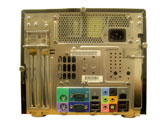 |
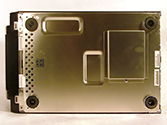 |
| Click on images to enlarge. | |
Since it's based on the same nForce4 chipset, the basic features are very similar to the Shuttle SN25P, the biggest competitor to the 330P. The differences are in the details. Where the SN25P has room for up to four hard drives, the 330P "only" has space for two. Two drives are generally enough for most people, so we're not too concerned. The 330P has two HDD cages that install into the top area of the case, and the power is provided for all the devices by a 300W PSU. In our testing, we didn't get above 235W under load, so 300W should be more than enough.
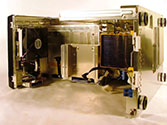 |
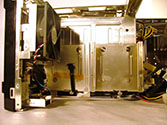 |
| Click on images to enlarge. | |
Another noteworthy difference is that a floppy drive can't be installed in the 330P; and when we say no floppy, we really mean no floppy - there isn't even a floppy cable connection on the motherboard. (Oddly enough, BIOS entries for FDD support still exist.) Frankly, we consider that to be a good thing. If you can't use a floppy drive, we would hope that support for all the critical functions is available without the floppy. SATA drive support for Windows works without a driver disk, and flashing the BIOS can be done from within Windows. You can also boot off of a flash device or USB stick if necessary. If you're looking to install XP to a RAID array, though, you're in for some problems. Your best bet would be to either slipstream the appropriate drivers onto an XP CD, or else try to use an imaging tool to restore a single hard drive image (with everything already set up) onto a RAID partition. An external USB floppy drive could also work. We didn't do any Linux compatibility testing either, so if that's your cup of tea, we'd suggest asking around the forums.
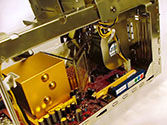 |
 |
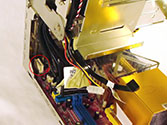 |
| Click on images to enlarge. | ||
In terms of expansion cards, the 330P receives top marks in the SFF market as it includes several options. First, you get the obligatory PCIe X16 slot. Next to that is a PCI slot, which is currently more useful than a PCIe X1 slot. On the other side of the case is another slot, but we're not quite sure what it is. (See the far right image above.) It's about the size of a PCIe X1 slot, but the wiring is clearly wrong. It's also not an AMR, CNR, or ACR as it's not the correct size for those either. The slot isn't mentioned anywhere in the manual or elsewhere, so it may simply be for internal debugging tools at Biostar. (We're trying to get an answer from Biostar about this slot.) Whatever the purpose of the slot, there isn't much room, so installing anything other than a very small card would be difficult. Besides the expansion slots on the top of the motherboard, Biostar has their "hidden" mini-PCI slot on the bottom of the case. If you're interested in adding WiFi connectivity to a SFF, it's a great option and it's something that we don't see in most other SFFs.
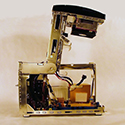 |
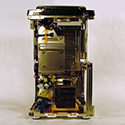 |
 |
| Click on images to enlarge. | ||
The big claim to fame of the new 300 series of Biostar cases is their hinged design. After removing the panels, you can lift up the entire front and top of the case to provide better access to the CPU socket, DIMM slots, etc. It does work, and it's a bit easier to install a lot of the equipment this way, but it isn't the most amazing thing in the world. If you were to access the internals of your system frequently, it would prove useful, but that's not usually how SFF owners use their systems. Would we purchase such a system over one of the other designs? All other things being equal, it's nice to have, but it's about the same as the tool-less features of the SN25P - good, but not something that would really sway our decision on its own. We'd buy the case for its appearance more than for the pop-top design.










29 Comments
View All Comments
JarredWalton - Friday, August 12, 2005 - link
I'll hit the KLOSS as soon as I can. (I have it already.) So unless someone else votes, I guess I'll get the KLOSS reviewed next.Sokolum - Thursday, August 11, 2005 - link
For the last 2 months now i have a ST20G5 using as a MCE system. There are a few problems what i have encounbtered, one of them is that the system behaviour changes when i change a setting within the BIOS. Those aren't dramatic changes. But with every change, it looks like that the graphics runs muchmore slower, you can see this with dragging a windows screen over your desktop, you get trails from that window...The system only runs smooth when i *don't* touch those setting. Happily the things keep running smoothly when i enlarge the shared video memory.
For the MCE side, i failed to make the Hauppauge 500MCE run compleetly as it should, i am only able to run TV 'Tunner 1' without problems when i *disable* TV 'Tunner 2' within windows Device Manager. Shuttle or Hauppauge couldn't help me with this case.
As the review documented, this is one of the cases that RAID is causing the problem in this story. In my MCE setup, i don't use RAID (there is *no* room for a seccond drive when you installed a floppy drive). Why RAID is the problem, what i have been told is that RAID wants to use al of the PCI bandwith. It seems the nature of RAID in this kind of systems, just een told, i am not for 100% sure, but it seems plausible to mee.
, a nice looking machine. I solved the problem for the flash cards with buying a floppy disk what come with a integrated card readed, see link:
http://www.alternate.nl/html/shop/productDetails.h...">http://www.alternate.nl/html/shop/productDetails.h...
mino - Thursday, August 11, 2005 - link
Jared I must confes, this is the _first_ time i see everclocking test done as it should have been. I really appreciate the comments for newbies (it makes easier to me to explain to them if you could reference somthing :). Also finally use of correct term oo A64 base freq./FSB issue. I think this way is it should be done for _all_ A64 motherboard review.1) do a maximum base freq. check (by keeping memfreq. around DDR400 + CPU not overclocked
2) do a max memclock test at 1T (with some proven components, just to check quality of CPU to MEM routing on the MB)
3) do some max. overclock test (actually this may be optional since it depend mostly CPU chosen)
Keep at this route and many readers may finaly undestand the basics of A64's OCing.
JarredWalton - Thursday, August 11, 2005 - link
I'm working on some detailed overclocking articles right now. Glad you enjoyed the section, and I'll be going into a LOT more detail (with benchmarks) on some future OC articles.dropadrop - Thursday, August 11, 2005 - link
Thanks for the nice review,If you are considering a followup I would love to see you test usb. While the usb on my sn95g5 v2 works for casual things like a mouse, digital camera and memory card reader, it does not work for an ipod shuffle, external soundcard (hercules dj console), or external hardisk.
There have been alot of people with similar experiences. It wold be great if you could find a way to test the sff's with a few "demanding" usb devices, and even measure the voltage (and stability of it) supplied via usb.
I also second the request for you to test the sn95g5 with an X2. The new bios surely supports them, as people in north america have been getting their current rigs modded by shuttle for support. I would love to see how your's supports it (and maby even venice / san diego) without being modded. I believe you would have the chance to help alot of confused SN95G5 users by trying out a few cpu's in it.
JarredWalton - Thursday, August 11, 2005 - link
I will definitely give it a shot. At present, my intention is to purchase an external IDE HDD enclosure with USB2.0 and 1394A support and do some file transfers and such between that and the system. The problem with that approach is that the enclosures all have an external power source. Can anyone recommend an inexpensive USB/Firewire HDD enclosure that gets the power over the USB port? http://www.newegg.com/Product/Product.asp?Item=N82...">I found this one, but I'm not really keen on spending $160 for something I don't personally need.dev0lution - Wednesday, August 10, 2005 - link
How come the SN25P details don't mention the update from nforce4 standard to nForce4 Ultra? I'm thinking of getting one so I went to the previous review and it lists chipset in the specs as the nForce 4 standard, but if you go to Shuttle's current product page for the SN25P it lists the chipset as the Nforce4 Ultra. Who's correct?JarredWalton - Thursday, August 11, 2005 - link
I think I may have just been lazy or neglectful in the original SN25P article. I'm pretty sure it was always nForce4 Ultra. Then again, regular nf4 vs. nF4U only adds SATA-II support IIRC. I don't see anything about SN25P supporting SATA-II which is sort of odd.Cookie Crusher - Wednesday, August 10, 2005 - link
I know it may be a "dated" or more "Entry Oriented" socket, but I have found that the socket 754 SFF systems are great for gaming and general use. Was there ever a roundup for them? If not, I'd like to see maybe a limited look at them to remind everyone that they are viable alternatives to, and about $75-$100+ cheaper than, these socket 939 options.I think it's important to point this out because of the note in the article that a SFF option incurs a premium....maybe so, but there are still cost effective options in that market. thanks.
Cookie Crusher - Wednesday, August 10, 2005 - link
Nevermind.....i found the roundup I was hoping for.....still, would be nice to make that reference to the older socket types as legitimate choices for SFF hopefuls on a budget. :-)